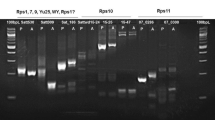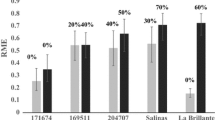Abstract
A given plant species is able to resist most of the potentially pathogenic microorganisms with which it comes in contact. This phenomenon, known as non-host resistance, can be overcome only by a very small number of ‘true pathogens’ which can use that plant as a host. In some cases, plants have developed mechanisms for overcoming infection by specific races or strains of a true pathogen. This race-specific resistance can be easily manipulated into agronomically important cultivars by plant breeders. We have previously described nine cDNA clones which represent pea genes active during non-host resistance against the fungus Fusarium solani f. sp. phaseoli. In the present work, we have used these cDNAs as probes to compare non-host resistance with race-specific responses of peas against three races of Pseudomonas syringae pv. pisi. Five of the genes most active during non-host resistance were also active in direct correlation with the phenotypic expression of resistance in race-specific reactions of five differential pea cultivars against three races of Pseudomonas syringae pv. pisi.
Similar content being viewed by others
References
EllistonJD, KucJ, WilliamsEB: Protection of Phaseolus vulgaris against anthracnose by Colletotrichum species non-pathogenic to bean. Phytopath Z 86: 117–126, 1976.
DalyJM: The role of recognition in plant disease. Ann Rev Phytopathol 22: 273–307, 1984.
FlorHH: Current status of the gene-for-gene concept. Ann Rev Phytopathol 9: 275–296, 1971.
FristenskyB, RigglemanRC, WagonerW, HadwigerLA: Gene expression in susceptible and disease resistant interactions of peas induced with Fusarium solani pathogens and chitosan. Physiol Plant Pathol 27: 15–28, 1985.
HadwigerLA, LoschkeDC. Molecular communication in host-parasite interactions: Hexosamine polymers (chitosan) as regulator compounds in race-specific and other interactions. Phytopathol 71: 756–762, 1981.
HadwigerLA, WagonerW: Effect of heat shock on the mRNA-directed disease resistance response of peas. Plant Physiol 72: 553–556, 1983.
HadwigerLA, WagonerW: Electrophoretic patterns of pea and Fusarium solani proteins synthesized in vitro or in vivo which characterize the compatible and incompatible interactions. Physiol Plant Pathol 23: 153–162, 1983.
HadwigerLA, WebsterDM: Resistance and phytoalexin production in five cultivars of peas differentially resistant to three races of Pseudomonas syringae pv. pisi. Phytopathol 74: 1312–1314, 1984.
HeathMC: Reactions of non-suscepts to fungal pathogens. Ann Rev Phytopath 18: 211–236, 1980.
Kraft JM, Burke DW, Haglund WA: Fusarium disease of beans, peas, and lentils. In: Nelson PE, Roussoun TA, Cook RJ (eds) Fusarium: Diseases, Biology and Taxonomy. The Pennsylvania State University Press, 1981, pp 142–156.
KucJ, RichmondS: Aspects of the protection of cucumber against Colletotrichum lagenarium by Colletotrichum lagenarium. Phytopathol 67: 533–536, 1977.
LegrandM: Phenylpropanoid metabolism and its regulation in disease. In: CallowJA (ed) Biochemical Plant Pathology. John Wiley and Sons, Ltd. New York, 1983, pp 367–384.
LittlefieldLJ: Flax rust resistance induced by prior inoculation with an avirulent race of Melampsora lini. Phytopathol 59: 1323–1328, 1969.
RigbyPWJ, DieckmannM, RhodesC, BergP: Labeling deoxyribonucleic acid to high specific activity in vitro by nick translation with DNA polymerase I. J Mol Biol 113: 237–251, 1979.
RigglemanRC, FristenskyB, HadwigerLA: The disease resistance response in pea is associated with increased levels of specific mRNAs. Plant Mol Biol 4: 81–86, 1985.
TaylorJD, VivianA, MalikA: Race structure in Pseudomonas syringae pv. pisi. In: ISPP Committee on Phytopathogenic Bacteria (ed) Proceedings of the 2nd Working Group on Pseudomonas syringae pathovars. The Hellenic Phytopathol. Soc., Athens, 1984, pp 90–91.
WagonerW, LoschkeDC, HadwigerLA: Two-dimensional electrophoretic analysis of in vivo and in vitro synthesis of proteins in peas inoculated with compatible and incompatible Fusarium solani. Physiol Plant Pathol 20: 99–107, 1982.
YarwoodCE: Some principles of plant pathology. II. Phytopathol 63: 1324–1325, 1973.
YoshikawaM: Macromolecules, recognition and the triggering of resistance. In: CallowJA (ed) Biochemical Plant Pathology. John Wiley and Sons, Ltd., New York, 1983, pp 267–298.
Author information
Authors and Affiliations
Rights and permissions
About this article
Cite this article
Daniels, C.H., Fristensky, B., Wagoner, W. et al. Pea genes associated with non-host disease resistance to Fusarium are also active in race-specific disease resistance to Pseudomonas . Plant Mol Biol 8, 309–316 (1987). https://doi.org/10.1007/BF00021310
Received:
Revised:
Accepted:
Issue Date:
DOI: https://doi.org/10.1007/BF00021310




